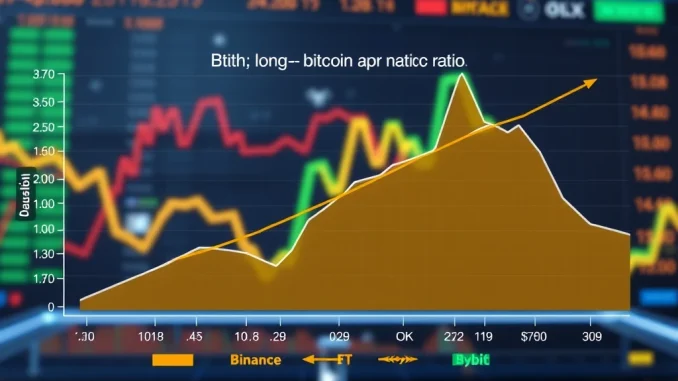
Are you trying to navigate the volatile world of cryptocurrency trading, specifically Bitcoin? Understanding market sentiment is absolutely crucial, and one powerful tool to gauge this sentiment is the Bitcoin long-short ratio. Let’s dive into the latest 24-hour snapshot of these ratios for BTC perpetual futures across leading cryptocurrency exchanges, offering you a glimpse into the prevailing market mood.
What is the Bitcoin Long-Short Ratio and Why Does It Matter?
Simply put, the Bitcoin long-short ratio indicates the proportion of traders who are betting on Bitcoin’s price going up (long positions) versus those who are betting on it going down (short positions). This ratio is a valuable indicator of overall market sentiment. A higher long ratio suggests bullish sentiment, while a higher short ratio hints at bearishness. However, it’s essential to remember that this is just one piece of the puzzle in cryptocurrency trading.
Why is this data so important? Here’s why traders pay close attention to these ratios:
- Gauge Market Sentiment: It provides a real-time snapshot of whether traders are predominantly optimistic or pessimistic about Bitcoin’s short-term price movement.
- Identify Potential Trend Reversals: Extreme long or short ratios can sometimes signal potential trend reversals. For instance, an overwhelmingly long market might be ripe for a correction, and vice versa.
- Inform Trading Strategies: Understanding the prevailing sentiment can help traders refine their strategies, whether it’s confirming their existing bias or prompting them to consider contrarian positions.
- Assess Exchange-Specific Sentiment: By looking at individual exchanges, you can see if sentiment varies across different trading platforms, which can be insightful.
Decoding BTC Perpetual Futures: A Trader’s Compass
Our focus here is on BTC perpetual futures. But what exactly are these? Unlike traditional futures contracts with expiration dates, perpetual futures, as the name suggests, have no expiration. They mimic spot market trading but with leverage, making them a popular instrument for crypto traders. The long-short ratio in perpetual futures is particularly relevant because it reflects the speculative positioning of traders in a highly liquid and actively traded market.
Key aspects of BTC perpetual futures to understand:
- No Expiration Date: Trade them indefinitely, unlike traditional futures.
- Leverage: Allows traders to control larger positions with less capital, amplifying both potential gains and losses.
- Funding Rates: A mechanism to keep the perpetual contract price anchored to the spot price. Positive funding rates mean longs pay shorts, indicating bullishness, and vice versa.
- High Liquidity: BTC perpetual futures markets are generally very liquid, ensuring tighter spreads and easier order execution.
24-Hour Snapshot: Long-Short Ratios Across Major Crypto Exchanges
Let’s get to the heart of the matter – the crypto exchange data for the past 24 hours. Here’s a breakdown of the long-short ratios across Binance, OKX, and Bybit, three of the leading cryptocurrency exchanges:
| Exchange | Long Ratio | Short Ratio |
|---|---|---|
| Binance | 49.95% | 50.05% |
| OKX | 49.39% | 50.61% |
| Bybit | 48.97% | 51.03% |
| Total Exchanges | 50.02% | 49.98% |

As you can see, across these major exchanges, the overall Bitcoin long-short ratio is remarkably balanced, with Long positions at 50.02% and Short positions at 49.98%. Looking at individual exchanges, we observe a slight variation:
- Binance: Almost perfectly balanced, indicating indecision or a highly contested market on this exchange.
- OKX: Slightly more short positions than long, suggesting a marginally bearish sentiment among OKX traders.
- Bybit: Shows the most pronounced leaning towards short positions, indicating a somewhat stronger bearish sentiment compared to Binance and OKX.
What Does This Data Tell Us About Bitcoin Trading Sentiment?
Interpreting this bitcoin trading sentiment data requires nuance. While the overall ratios are very close to 50/50, suggesting a generally neutral sentiment across the board, the slight variations on individual exchanges offer more granular insights.
Neutral Overall Sentiment: The near 50/50 split across all exchanges collectively points to a market in equilibrium. Neither bulls nor bears are dominating significantly at this moment. This could imply a period of consolidation, uncertainty, or anticipation of a major market event.
Exchange-Specific Nuances: The slight bearish tilt on OKX and Bybit, especially Bybit, could indicate localized bearishness on these platforms. This might be due to specific user demographics on these exchanges, regional news impacting sentiment, or even just random fluctuations. It’s important not to overemphasize minor differences, but they are worth noting.
Consider Context: Long-short ratios are most effective when viewed in context. Consider:
- Historical Ratios: How do these ratios compare to previous days or weeks? A sudden shift can be more significant than the absolute ratio itself.
- Price Action: Correlate ratios with Bitcoin’s price movements. Are ratios confirming price trends or diverging from them?
- Other Indicators: Use long-short ratios in conjunction with other technical and on-chain indicators for a more holistic market view.
- Market Events: Major news events, regulatory announcements, or macroeconomic data releases can significantly impact sentiment and, consequently, long-short ratios.
Actionable Insights: Leveraging Long-Short Ratios for Market Analysis
So, how can you use this market analysis data to your advantage as a cryptocurrency trader?
- Confirmation Tool: Use long-short ratios to confirm your existing trading bias. If you are bullish on Bitcoin and see a rising long ratio, it might strengthen your conviction. Conversely, if you are bearish and see increasing short positions, it could add to your bearish outlook.
- Contrarian Signals (With Caution): Extremely skewed ratios can sometimes act as contrarian indicators. An overwhelmingly long market could become vulnerable to a long squeeze, and vice versa for a heavily shorted market. However, contrarian trading is risky and requires careful consideration of other factors.
- Exchange Sentiment Comparison: Monitor differences in sentiment across exchanges. Significant divergences might highlight specific trading opportunities or risks associated with certain platforms.
- Combine with Technical Analysis: Integrate long-short ratio analysis with your technical analysis. For example, if you see a bearish chart pattern forming and the long-short ratio is also increasing, it might provide a stronger sell signal.
- Risk Management: Be mindful of extreme ratios. Highly leveraged markets with skewed sentiment can be more prone to volatility and sudden price swings. Adjust your position sizing and risk management accordingly.
In Conclusion
The 24-hour Bitcoin long-short ratio data reveals a market currently in a state of delicate balance. While the overall sentiment appears neutral, subtle differences across exchanges and the broader market context are crucial for informed trading decisions. By understanding and monitoring these ratios, and integrating them into your comprehensive market analysis, you can gain a valuable edge in navigating the exciting, yet often unpredictable, world of Bitcoin and cryptocurrency trading. Stay informed, stay vigilant, and trade wisely!



